
The Temple in Jerusalem was any of a series of structures which were located on the Temple Mount in the Old City of Jerusalem, the current site of the Dome of the Rock and Al-Aqsa Mosque. These successive temples stood at this location and functioned as a site of ancient Israelite and later Jewish worship. It is also called the Holy Temple.

A temple is a building reserved for spiritual rituals and activities such as prayer and sacrifice. The term typically used for such buildings belonging to all faiths where a more specific term such as church, mosque or synagogue is not generally used in English. These include Hinduism, Buddhism, Sikhism and Jainism among religions with many modern followers, as well as other ancient religions such as Ancient Egyptian religion.
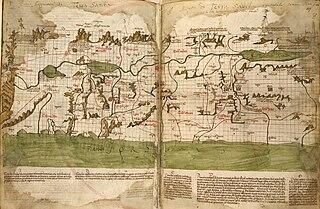
The Holy Land is an area roughly located between the Mediterranean Sea and the Eastern Bank of the Jordan River. Traditionally, it is synonymous both with the biblical Land of Israel and with the region of Palestine. The term "Holy Land" usually refers to a territory roughly corresponding to the modern State of Israel, the Palestinian territories, western Jordan, and parts of southern Lebanon and southwestern Syria. Jews, Christians, and Muslims regard it as holy.
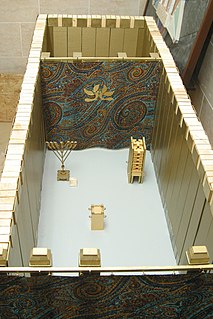
The Holy of Holies or HaDvir is a term in the Hebrew Bible which refers to the inner sanctuary of the Tabernacle where God's presence appeared. According to Hebrew Tradition, the area was defined by four pillars which held up the veil of the covering, under which the Ark of the Covenant was held above the floor. The Ark according to Hebrew Scripture contained the Ten Commandments, which were given by God to Moses on Mount Sinai. King Solomon built the Temple in Jerusalem, where the Ark of the Covenant was supposed to be kept.

A sacred grove or sacred woods are any grove of trees that are of special religious importance to a particular culture. Sacred groves feature in various cultures throughout the world. They were important features of the mythological landscape and cult practice of Celtic, Estonian, Baltic, Germanic, ancient Greek, Near Eastern, Roman, and Slavic polytheism, and continue to occur in locations such as India, Japan, and West Africa. Examples of sacred groves include the Greco-Roman temenos, various Germanic words for sacred groves, and the Celtic nemeton, which was largely but not exclusively associated with Druidic practice. During the Northern Crusades, there was a common practice of building churches on the sites of sacred groves. The Lakota and various other North American tribes consider particular forests or other natural landmarks to be sacred. Singular trees which a community deems to hold religious significance are known as sacred trees.

A fire temple, Agiary, Atashkadeh, Atashgah (آتشگاه) or Dar-e Mehr is the place of worship for the followers of Zoroastrianism, the ancient religion of Iran (Persia). In the Zoroastrian religion, fire, together with clean water, are agents of ritual purity. Clean, white "ash for the purification ceremonies [is] regarded as the basis of ritual life", which "are essentially the rites proper to the tending of a domestic fire, for the temple [fire] is that of the hearth fire raised to a new solemnity". For, one "who sacrifices unto fire with fuel in his hand ..., is given happiness".
The Latin phrase sanctum sanctorum is a translation of the Hebrew term קֹדֶשׁ הַקֳּדָשִׁים which generally refers in Latin texts to the holiest place of the Tabernacle of the Israelites and later the Temple in Jerusalem, but also has some derivative use in application to imitations of the Tabernacle in church architecture.
Tirtha is a Sanskrit word that means "crossing place, ford", and refers to any place, text or person that is holy. It particularly refers to pilgrimage sites and holy places in Hinduism as well as Jainism.

The city of Jerusalem is sacred to many religious traditions, including the Abrahamic religions of Judaism, Christianity and Islam which consider it a holy city. Some of the most sacred places for each of these religions are found in Jerusalem and the one shared between all three is the Temple Mount.

Parikrama or Pradakshina refers to circumambulation of sacred places to imbibe their energy in Sikh, Hindu, Jain or Buddhist context, and the path along which this is performed. Parikrama means "the path surrounding something" in Sanskrit, and is also known as Pradakshina, representing circumambulation. Both words are mostly used in the context of religious deities in a temple, sacred rivers, sacred hills and a close cluster of temples, and "doing a parikrama" as a symbol of prayer is an integral part of Hindu worship. In Hinduism and other Indian religions, the Parikrama inside temples or sacred sites is traditionally clockwise.
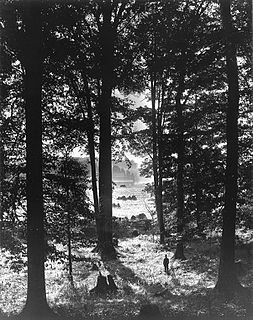
The Sacred Grove is a forested area of western New York near the home of Joseph Smith where the foundational event of the Latter Day Saint movement took place. It is the location where Smith said he had his First Vision, a theophany, occurring in the spring of 1820.
In Hindu religion and spirituality, the pilgrimage has great significance. Members of the faith participate in the following types of pilgrimage. The pilgrimage to each sacred site has its own religious significance.
Sacred describes something that is dedicated or set apart for the service or worship of a deity; considered worthy of spiritual respect or devotion; or inspires awe or reverence among believers. The property is often ascribed to objects, or places.
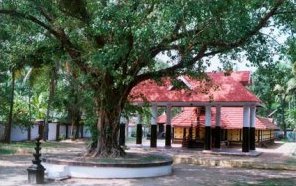
Thamaramkulangara Sree Dharma Sastha temple is one of the most prominent temple in Tripunithura, Kochi in the state of Kerala. It is dedicated to Lord Ayyappa worshiped as Dharmasastha.

Pura Ulun Danu Batur is a Hindu Balinese temple located in the island of Bali, Indonesia. As one of the Pura Kahyangan Jagat, Pura Ulun Danu Batur is one of the most important temples in Bali which acted as the maintainer of harmony and stability of the entire island. Pura Ulun Danu Batur represents the direction of North and is dedicated to the god Vishnu and the local goddess Dewi Danu, goddess of Lake Batur, the largest lake in Bali. Following the destruction of the original temple compound, the temple was relocated and rebuilt in 1926. The temple, along with 3 other sites in Bali, form the Cultural Landscape of Bali Province which was inscribed as World Heritage Site by UNESCO in 2012.
The New Church of the Theotokos was a Byzantine church erected in Jerusalem by the Byzantine Emperor Justinian I. Like the later Nea Ekklesia in Constantinople, it is sometimes referred to in English as "The Nea".
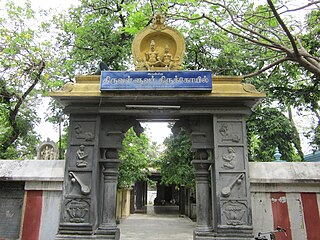
Thiruvalluvar Temple is a temple dedicated to the poet-saint Valluvar in the neighborhood of Mylapore in Chennai, India. The temple is located within the Ekambareswarar temple complex. Believed to have been constructed in the early 16th century, the temple was extensively renovated in the 1970s. The temple is under the control of the Hindu Religious and Charity Endowment Department. The temple also serves as the venue for meetings of Tamil language enthusiasts.
Sanctum is a sacred place, in a shrine within a temple or church. It also refers to a sacred place of pilgrimage.










